Getting to know a wine region is a bit like getting to know a person. Time is an ally. Over the last year or so, I’ve had several opportunities to get to know the wines of Alentejo by means of educational and sample programs. The most recent educational program was focused on Alentejo’s award-winning sustainability program (click here to read Alentejo On My Mind; Part 1-Sustainability.
About The Wines of Alentejo
The Alentejo (ah-len-TAY-zhoo) is located in southern Portugal. It’s a sizable region about the size of the state of Massachusetts, that covers about a third of the country. It has a long history as a major producer of grains and corks. In fact, nearly half of the world’s supply of corks is sourced from the region’s cork oak trees
Winemaking in the Alentejo dates back 4,000 years, but it wasn’t until the 1980s when investment from the European Union enabled a number of cooperatives to focus on elevating the quality of its wines. Over the last 25 years the region has seen an over 400% growth in the number of producers. Most of the wineries are family owned and operated. The region has dominated the domestic market share since 2010. While its easy drinking, rich and fruity wines are the darlings of Lisbon cafés and restaurants, the region also features more complex fine wines, especially reds.
Alentejo offers a diverse mix of native grape varieties, varieties with origins in other parts of Portugal and international grapes (e.g. Cabernet Sauvignon and Syrah). Its predominant wines are approachable and generous red blends, and exciting, aromatic whites wines. What also makes the region special is that it offers the best of ancient and modern winemaking practices, including Talha (amphora) wines.

The region’s terroir is comprised of an undulating topography, a mostly hot and dry climate that makes irrigation necessary, and a mix of heterogeneous soil types including schist, pink marble, granite, limestone, often laid upon a sub-layer of water-retaining clay. Alentejo is threatened by global warming, therefore sustainability is a top priority.
Alentejo has its own DOC/DOP (appellation) title, as well as a wider Vinho Regional Alentejano designation. The DOP has eight subregions (see map above), which span from the mountains to the hot, dry center of the region: Portalegre, Borba, Évora, Redondo, Reguengos, Granja-Amareleja, Vidigueira and Moura.
Roughly 80% of the region’s wines are red, with whites wines at 19% and and rosé wine (less than 2%). Blended wines are the rule rather than the exception.
I’ve selected nine wines (4 white and 5 reds) that are fine exemplars of the Alentejo. You’ll find my comments and tasting notes below.
There are two levels of certification represented in this group of wines. Wines certified as Denominação de Origem Alentejo (Denominação de Origem Controlada Alentejo also DOC Alentejo) must meet the most restrictive vineyard yields, allowed blending varieties and blending proportion requirements(refer to the label on the left below for what you will see on each bottle of DOC Alentejo wine).

Indicação Geogràfica Alentejano (Vinho Regional Alentejano) allows higher vineyard yields and more flexibility in the use of blending grapes (refer to the label on the right above for what you will see on each Vinho Regional Alentejo bottle).
Disclosure: I received these wines as a media samples. I received no compensation for this post, and all opinions presented are my own.
The White Wines
Antão Vaz (ANT-ow VASH), which is native to the region, is its most exciting white grape. Other white grapes used in blends include Arinto and Roupeiro .
2014 Herdade do Rocim Olho de Mocho Branco, Vinho Regional Alentejo

This outstanding wine is golden yellow color with honeysuckle, lemon curd, quince paste, mandarin orange and wet stone aromas. On the palate, it’s full bodied, rich and broad on the palate with mouthwatering acidity. It shows Mixed cirrus, lemon curd and green pear flavors with an appealing saline minerality and a long finish 100% Antão Vaz 13.5% abv| SRP-$30.
Pair with grilled fish, or even better Setubal Style Grilled Fish!
2016 Herdade da Malhadinha Antão Vaz da Peceguina, Vinho Regional Alentejo
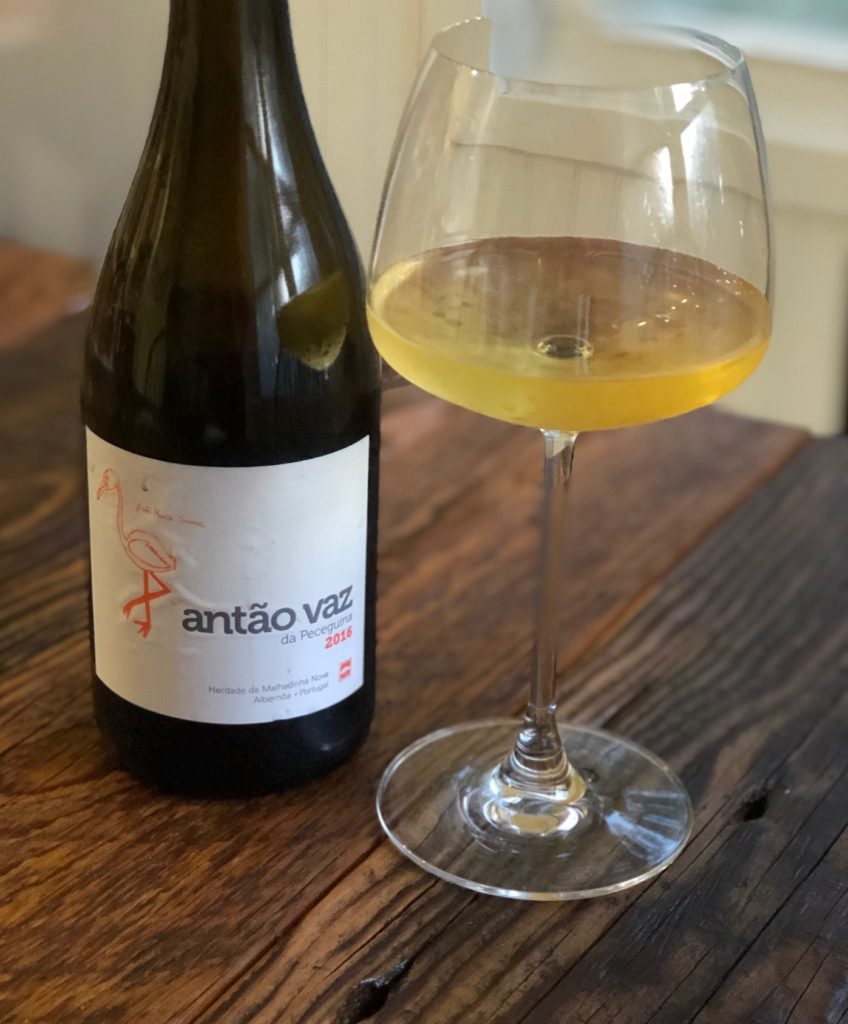
This 100% Antão Vaz wine showcases the grape in all its naked glory. It was vinified in 100% stainless steel. This alluring wine has a very fresh tropical fruit, orange peel, apricot, and honey character accented with a very appealing salinity. It played pretty well with our sushi and sashimi. 13% abv|SRP – $25
2018 FitaPreta Branca, Vinho Regional Alentejo

This exciting wine is a blend of 40% Antão Vaz, 40% Roupeiro and 20% Arinto, mostly sourced from vineyards between 30-47 years of age and planted on infertile schist rock soil. It’s a pale straw yellow color with expansive yellow apples, peach cobbler crust, lemon cream, honey and wet stone aromas. On the palate it’s medium-bodied with mouth-watering zesty acidity and very pleasing mouthfeel. It shows intriguing notes of yellow apple, lemon zest, honey, dried apricot and green melon beautifully accented with a wet stone minerality. Long finish. 13% abv|SRP – $22
2017 Esporão Monte Velho White Blend, Vinho Regional Alentejano

A blend of 40% Antao Vaz, 40% Roupeiro, and 20% Perrum, this wine pours a pale yellow-gold color with stone, and tropical fruit, floral, honey, spice and a hint of wet stone aromas. On the palate, it’s medium-bodied with medium acidity and ample ripe white peach, mango, grilled pineapple, dried apricot, and honey flavors with an appealing supple texture and a lingering spicy finish. 14.5% abv|SRP – $12 (which is incredible quality for the price)
The Red Wines
Iberian red grapes used in blends across the region include Aragonez (Tempranillo), Alicante Bouschet, Touriga Nacional, Alfrocheiro, Castelão, Trincadeira, and Moreto. Alicante Bouschet (Ah-lee-KAN-tay Boo-SHAY) originated in France, but it has found a home in Alentejo, where it thrives in the region’s hot and dry climate. These days, Alicante Bouschet is enjoying a renaissance of sorts. When grown properly, it is capable of making great wine that is fruity, fresh and balanced. International varieties like Cabernet Sauvignon and Syrah (which is seriously gaining in importance) round out the grapes used blends throughout the region.
2016 Herdade Do Rocim Alicante Bouschet, Vinho Regional Alentejano
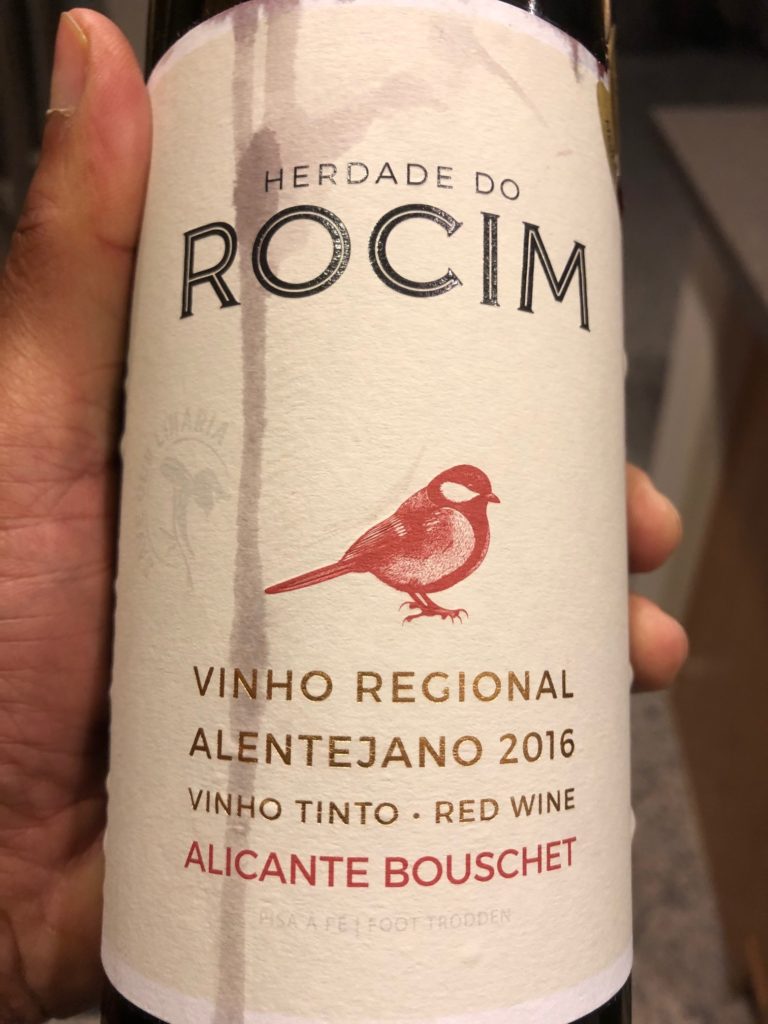
The wine pours an opaque purple color with aromatic and appealing black cherry, plum, bramble, white leather, clove, subtle violet and white pepper aromas. On the palate it’s fruit forward, but not overly so, and delicious with good structure composed of vibrant acidity, velvety tannins and some savory inviting savory notes. It shows alluring ripe black cherry, plum, red currant and spice flavors accented with kiss of minerality. 100% Alicante Bouschet. 14.5% abv|SRP ~ $20. Fabulous QPR!
2015 Herdade de São Miguel Alicante Bouschet, Vinho Regional Alentejano
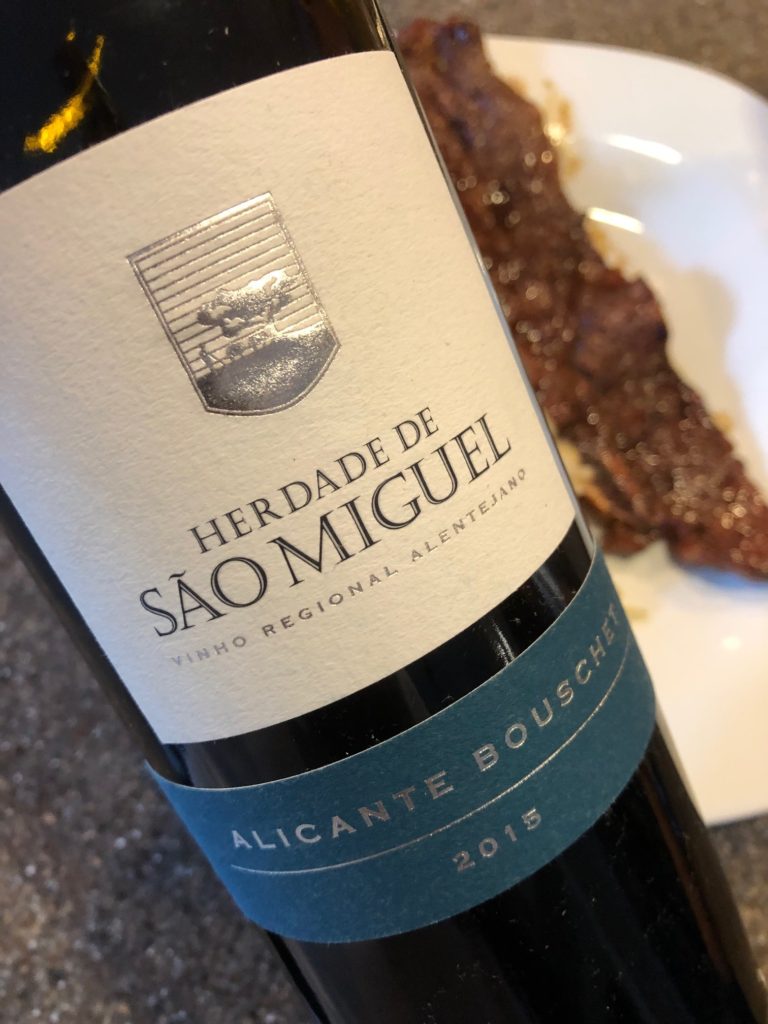
The lovely wine pours an inky purple with inviting blueberry, blackberry, charcoal, violets and red licorice aromas. On the palate it’s medium-bodied with firm tannins. It shows ample blackberry, blueberry, black cherry graphite flavors with medium acidity and finish. Vineyard planted on clay and schist soils. 100% Alicante Bouschet. Aged 12 months in 400 liter French oak barrels. 15% abv|SRP – $23 Another high QPR gem! Drink now with at least a 40 minute decant, or cellar 3-5 years.
2015 Herdade da Malhadinha Nova Monte da Peceguina, Vinho Regional Alentejano
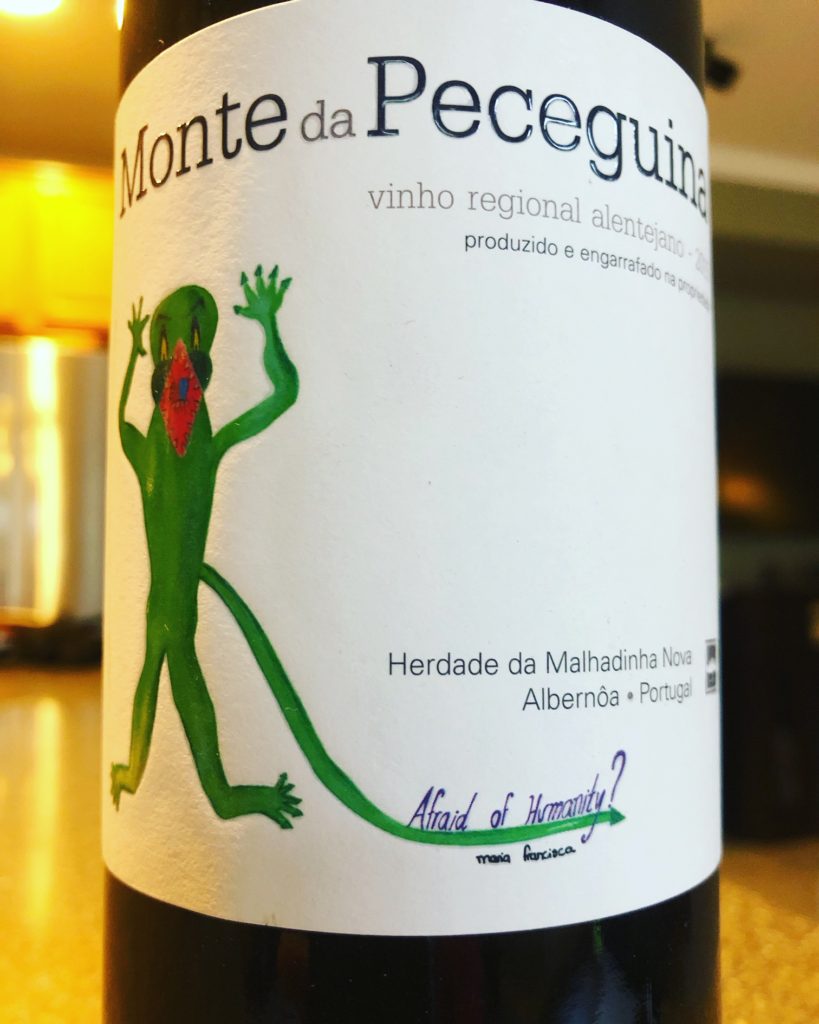
This wonderful wine is made in the more modern, or international style. It’s a ruby color with black fruit, damp clay, eucalyptus, dried herb aromas with a hint of lavender. On the palate it’s medium-bodied and fresh with a supple, velvety tannins with notes of blackberry, black currant, black cherry,vanilla, cacao, and graphite with a very satisfying finish. It’s a blend of 25% Touriga Nacional, 23% Syrah, 22% Aragonez, 20% Alicante Bouschet, and 10% Cabernet Sauvignon. Partially aged for 9 months in French oak barrels | 14.5% abv| SRP – $19
2013 Cartuxa Évora Tinto Colheita, DOC Alentejo-Évora
Cartuxa, is a historic winery with almost “cult” status amongst Portuguese wine cognoscenti. It is situated just outside of Alentejo’s capital, Évora – a UNESCO World Heritage Site.

This distinguished wine is a blend of Aragonez (a.k.a.Tempranillo), Alicante Bouschet, Trincadeira and Cabernet Sauvignon aged in barrels and vats for 12 months followed by another 12 months in bottle before release. It’s a ruby color with very appealing spiced baked plum, candied cherry, fresh plum, leather and oak aromas. On the palate, it’s medium-bodied and harmonious with mouthwatering acidity and well-integrated tannins. It shows notes of plum, black cherry, red currant, dried herbs and spice with a very satisfying savory finish. It paired beautifully with Smoked Dry Rubbed Baby Back Ribs!14.5% abv|SRP – $25.
2014 Piteira Tinto de Talha, DOC Alentejo
Alentejo is the only region in Portugal where the ancient technique of making wines in clay jars (‘talha”) is still alive and well. The region is renown for its coterie of producers preserving this 2,000-year tradition.
For example, winemaker José Piteira uses Moreto, an indigenous red grape, from 30- to 80-year-old ungrafted vines to elaborate the 2014 Piteira Tinto de Talha. Destemmed grapes are crushed by hand and the must and skins are deposited into large (holding 520 gallons!) hand-made clay jars. Fermentation lasts up to three months during which a rodo–a tool similar to a squeegee-is used to rotate the wine and lees daily.
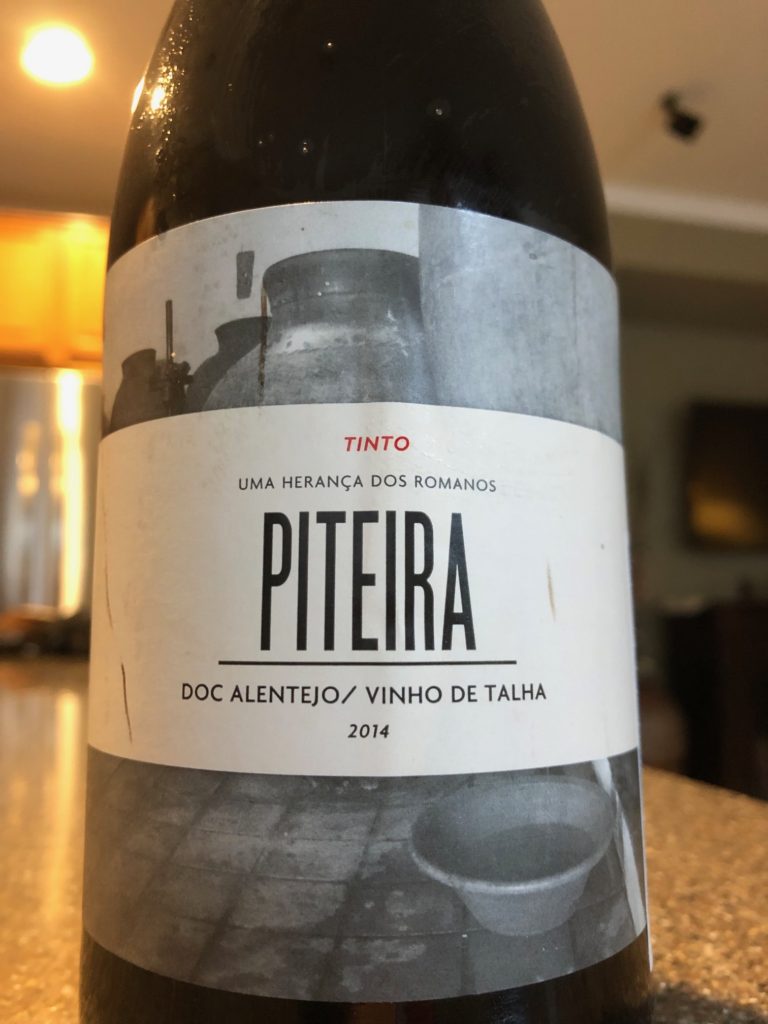
The wine is purple hued with plum, dark berry and spice aromas. On the palate it’s light-bodied with firm, rustic tannins and an easy going, tart blueberry, plum and plum skin flavors. 14% abv| SRP – $23|
Top Five Reasons Why Alentejo Wines Should Be On Your Radar
- I found its red wines to be generous and approachable, and its white wines (particularly the Antao Vaz bottlings) to be aromatic and very fresh. All the wines I tasted were very food friendly.
- Diversity – There are a large number of indigenous grape varieties (including Antao Vaz) found in the Alentejo, which impart a strong regional distinctive character to the wines and which are extremely well adapted to the geography and climate of the region.
- A compelling mix of ancient and modern winemaking practices, including wines made in amphora (Alentejo is the only region of Portugal in which this ancient technique is practiced)
- Value – I couldn’t believe the quality to price ratio of the wines I tasted. Alentejo offers superb value across the board.
- Sustainably Crafted Wines – The Wines of Alentejo Sustainability Program (“WASP”) is award winning, world-class sustainability program, and the only sustainability program in Portugal (see my post about WASP here)
I hope my exploration of Alentejo wines has piqued your interest in this very exciting Portuguese region.
Located about 90 minutes away from Lisbon, the gastronomic capital of Portugal, aside from its captivating wines, the region offers a thriving oenotourisme industry. Its captivating and diverse scenery— walled hilltop towns with castles and Roman, miles of nearly deserted white beaches on the western coast, and hills dotted with cork trees are just a few of the sights to see and experience in the Alentejo.
Thank you to Creative Palate Communications for providing the amazing educational and sampling opportunities for exploring the wines of Alentejo.
Follow me on Twitter, Facebook, Instagram, Vivino and for all things wine. As a wino with latent foodie tendencies, you’ll also find plenty of food and wine pairings, and wine related travel stuff! Become a fan and join ENOFYLZ Wine Blog on Facebook. Cheers!
Copyright Notice: This entire site is Copyrighted 2010-2020. All Rights Reserved. No unauthorized copying of any section of this site is permitted. If you wish to use any part of this site, contact me. For information on Copyright Law, see the official U.S. Copyright Office home page.
I’ve so enjoyed learning more about Alentejo wines through your articles. Hoping our canceled trip the the region will be doable in 2021!
Thanks Allison. I hope your cancelled trip is doable in 2021 too! After my virtual exploration of the region, I too would like to visit!
I really enjoyed round one, this one right up there. Alentejo is one of our fav places for a weekend wine exploration getaway. When we can move again, let’s meet there!
Alentejo wines are very popular in Irish independent wine shops: fantastic wines at modest prices!